Planning to go camping in Banff? Read my in-depth guide packed with everything you need to know before you head off on your Banff camping trip.
There’s something special about camping in Banff National Park.
The feeling of waking up to the sounds of the forest in the morning, fresh, crisp air in your lungs and the wind rustling through the trees – and, if you’re lucky, a stunning view of the Canadian Rockies right in front of you.
For people who enjoy bundling up in a sleeping bag and dozing off in a tent, camping in Banff National Park is a must-do.
With front country camping lots that have amenities like electricity hookups and showers, to backcountry camping areas in some of the most gorgeous spots in the park, the campsites in Banff are the perfect places to pitch your tent after a long day of hiking.
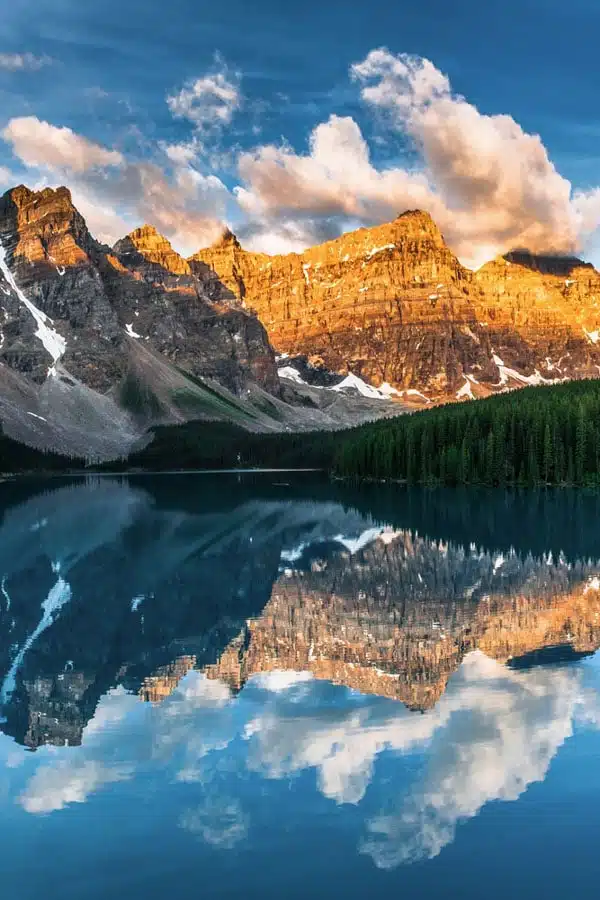
Campsites in Banff National Park
Frontcountry Campgrounds in Banff National Park for Tent Campers
Tent camping is the most popular type of camping in Banff and is really easy to do, as long as you have the right gear! It’s important to try and make reservations before your trip, so you’ll be guaranteed a place to camp during your time in Banff.
You can reserve campsites in Banff here and check fees and pricing for Banff campsites here.
We strongly recommend moving around to a few different campsites during your trip so you can experience many different parts of the park.
Here’s a short overview of each of the campsites in Banff, where they’re located, and what to expect while you’re there.
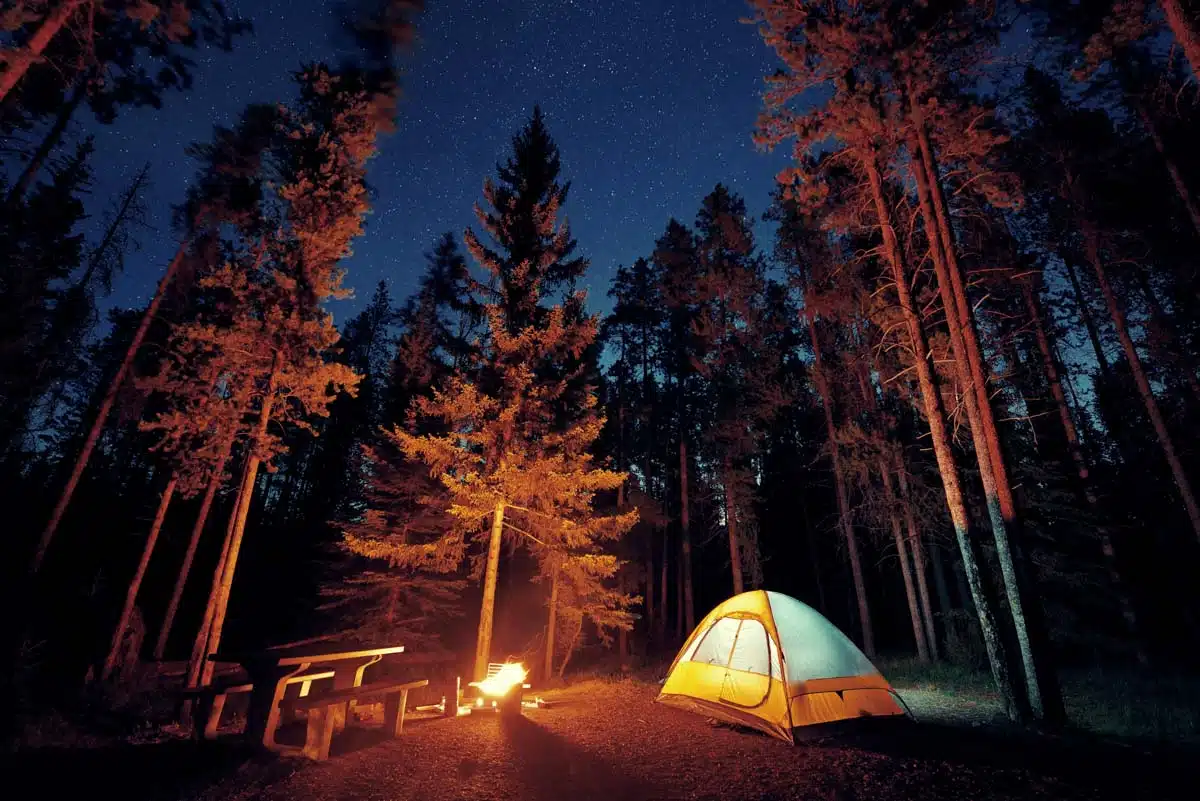
Tunnel Mountain Village I
- Open dates: June to October 6
- Number of sites: 618
- Types of camping available: Tent & campervan/RV
- Amenities: Toilets and showers with hot water, fire pits
The Tunnel Mountain Village I campground is one of the most popular campsites in Banff National Park, given its close proximity to Banff town center. It’s located in a forested area where you’ll get ample protection from windy days.
With running water, showers, and fire pits, Tunnel Mountain I has basically everything you might need, even if you’re new to camping. Plus, the views of the nearby mountains are gorgeous!
Tunnel Mountain Village II
- Open dates: Year round
- Number of sites: 188
- Types of camping available: Tent & campervan/RV
- Amenities: Electrical hookups, flush toilets, hot & cold showers, fire pits
Tunnel Mountain Village II is one of the Banff campgrounds located very close to Banff town, and it’s the only one out of all the campgrounds in Banff that’s open year round. It’s fully stocked with amenities, from electrical hookups to hot showers, and there’s even a shuttle to and from Banff town.
Most of the spaces here are designed from campervans/RVs, but there are over 30 tent camping spots for people who want to camp close to the town.
Two Jack Main
- Open dates: June 20 to September 2
- Number of sites: 349
- Types of camping available: Tent & campervan/RV
- Amenities: Flush toilets & fire pits
A more primitive campsite than the Tunnel Mountain Village campgrounds, Two Jack Main is located near Lake Minnewanka and Mount Rundle, just a few minutes’ drive from Two Jack Lake. Here, you’ll find a forested area boasting well over 300 campsites. There’s running water and fire pits, but if you’re looking for a hot shower, you’ll need to reserve somewhere else.
Two Jack Lakeside
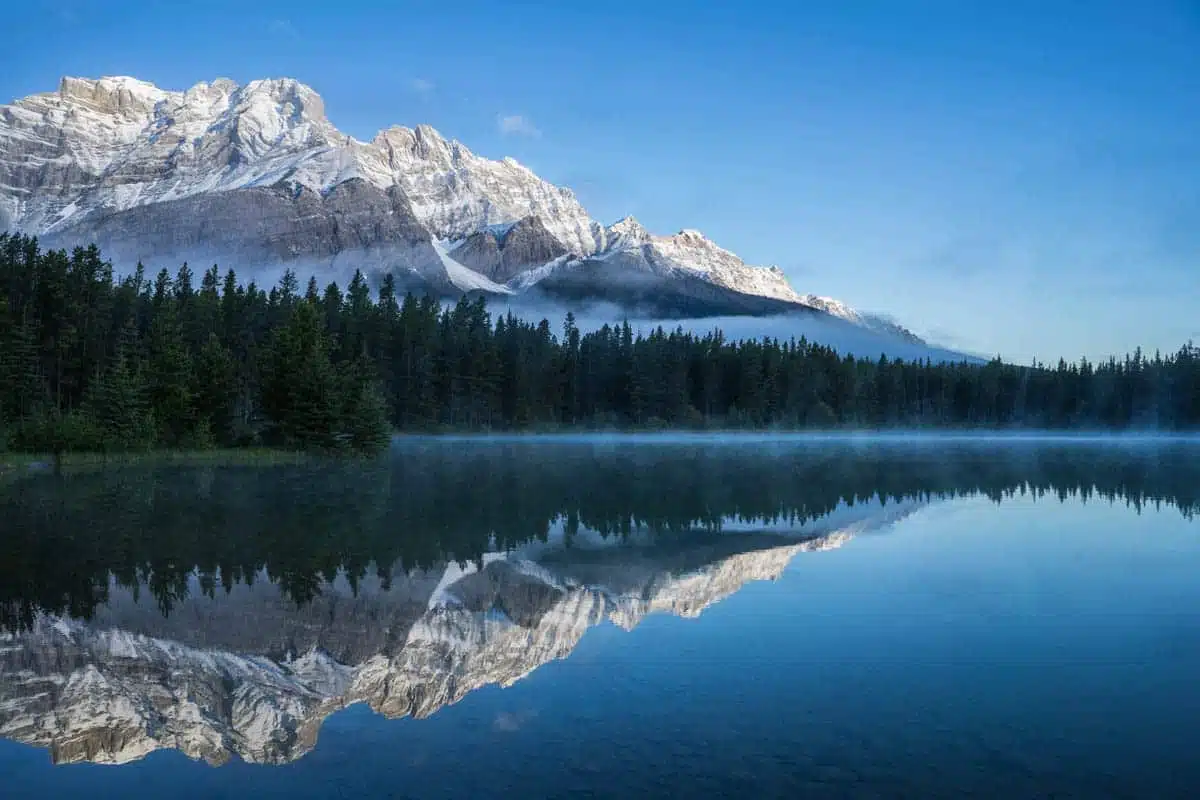
- Open dates: May 9 to October 7
- Number of sites: 64
- Types of camping available: Tents only
- Amenities: Flush toilets, hot & cold showers, fire pits
Alas, my favorite campsite in ALL of Banff National Park: Two Jack Lakeside. It’s a smaller camping area, with 64 spots available for tent campers only, but the views are really, really incredible.
You’ll wake up to the sounds of birds and stunning views of Mount Rundle, reflecting in the glass-like lake. On clear nights, you can catch starry vistas above the trees. What’s better than sleeping in one of the most picturesque campgrounds in Banff National Park? Nothing, nothing at all.
Pro tip: Book this one early in the season to get a lakeside campsite – you won’t regret it!
Johnston Canyon
- Open dates: Check to confirm
- Number of sites: 132
- Types of camping available: Tent & campervan/RV
- Amenities: Flush toilets, hot & cold showers, fire pits
Johnston Canyon is a fabulous place to go camping in Banff, if not for the fact that it’s right next to the Johnston Canyon hiking trail (which is one of the most popular hikes in Banff). It’s in a pretty forested area and has all of the tent camping amenities you could want, including hot and cold showers and fire pits.
Fun story: When I was last there, we were warned of “bold wolves” and told to take everything scented out of our tents, including toothpaste!
Luckily, the wolves didn’t think I smelled like a gourmet dinner and decided to pass on me, but it’s a good idea to check with the rangers at the campgrounds in Banff nonetheless.
Castle Mountain
- Open dates: May 30 to September 6 (Closed for 2022)
- Number of sites: 43
- Types of camping available: Tent & campervan/RV
- Amenities: Flush toilet, fire pits
And good news for the last minute trip planners – the Castle Mountain campsite is first come first serve ONLY. That means you can’t reserve it at all! If you’re looking for a place to stay in Banff, this is a great option that doesn’t require any kind of reservation. Just note that with first-come first-served campsites, you’ll need to provide your credit card number or cash.
Protection Mountain
- Open dates: June 21 to September 2
- Number of sites: 72
- Types of camping available: Tent & campervan/RV
- Amenities: Flush toilets, fire pits
Located near Lake Louise off the Bow Valley Parkway, Protection Mountain is a campsite with incredibly scenic views and a fantastic location for exploring the northern part of Banff. Here, you can find even more of that coveted first-come first-served camping in Banff. (You won’t need a reservation to enter this campsite, just use a self-serve payment envelope.) Note that there are no showers, so if you want to take a hot shower, don’t choose this campsite.
Lake Louise
- Open dates: May 30 to September 30
- Number of sites: 206
- Types of camping available: Tent or tent + campervan
- Amenities: Flush toilets, hot & cold showers, fire pits
If you want great proximity to the Lake Louise area, look no further than the Lake Louise campground. One of the most coveted campgrounds in Banff, you’ll want to try and book this one in advance.
Here, you can pitch your tent just 1 kilometer away from Lake Louise (4km from the actual lake) and enjoy the fabulous hikes and views nearby. Here, you have all the amenities you might need, and because it’s so close to Lake Louise, you can also get snacks and gear at one of the shops in the village. This campsite is basically the best of both worlds!
Mosquito Creek
- Open dates: May 31 to October 14
- Number of sites: 32
- Types of camping available: Tent & campervan/RV
- Amenities: Dry toilet (outhouse) and fire pit
Located on the Icefields Parkway, Mosquito Creek campground is a somewhat primitive campsite with awesome access to the hikes and nearby views that the Columbia Icefield offers. The name Mosquito Creek shouldn’t scare you – there are actually no more mosquitos here than normal! And lucky for you, this campsite is first-come first-served, meaning you can just show up and claim a campsite.
Pro tip: Camping on the Icefields Parkway also gives you access to many of the amazing hikes in Jasper and the surrounding areas, since these campsites lie between the two parks. Just some food for thought…
Silverhorn Creek
- Open dates: May 31 to September 30
- Number of sites: 45
- Types of camping available: Tent & campervan/RV
- Amenities: Dry toilet (outhouse), fire pits
Another campground in Banff located in the Icefields Parkway area, Silverhorn Creek is another first-come first-served campsite that boasts amazing views and awesome proximity to the Columbia Icefield. It’s also more primitive than the other campsites, with a dry toilet and no running water. What it lacks in amenities it makes up for in awesome picturesque scenery!
Waterfowl Lakes
- Open dates: June 21 to September 3
- Number of sites: 116
- Types of camping available: Tent & campervan/RV
- Amenities: Flush toilet, fire pits
Waterfowl Lakes is likely the most popular of the Icefields Parkway campsites in Banff, most likely due to the fact that it has the largest amount of campsites. The campground is in a nice, wooded area welcoming tents and campervans, and it’s the only Icefields Parkway campground with running water. You can’t exactly shower, but you’ll at least get a nice warm sponge bath in if you’re so inclined.
Rampart Creek
- Open dates: May 31 to October 14
- Number of sites: 50
- Types of camping available: Tent & campervan/RV
- Amenities: Dry toilet (outhouse), fire pits
Rampart Creek is the last of the Icefields Parkway campsites on our list, and it’s a first-come first-served campsite with primitive facilities.
(Side note: isn’t it great that you can literally just drive up the Icefields Parkway and pop into all these first-come first-served campsites?) Here, you’ll find a peaceful wooded area with campsites and fire pits, perfect for enjoying everything that the Icefields Parkway area has to offer.
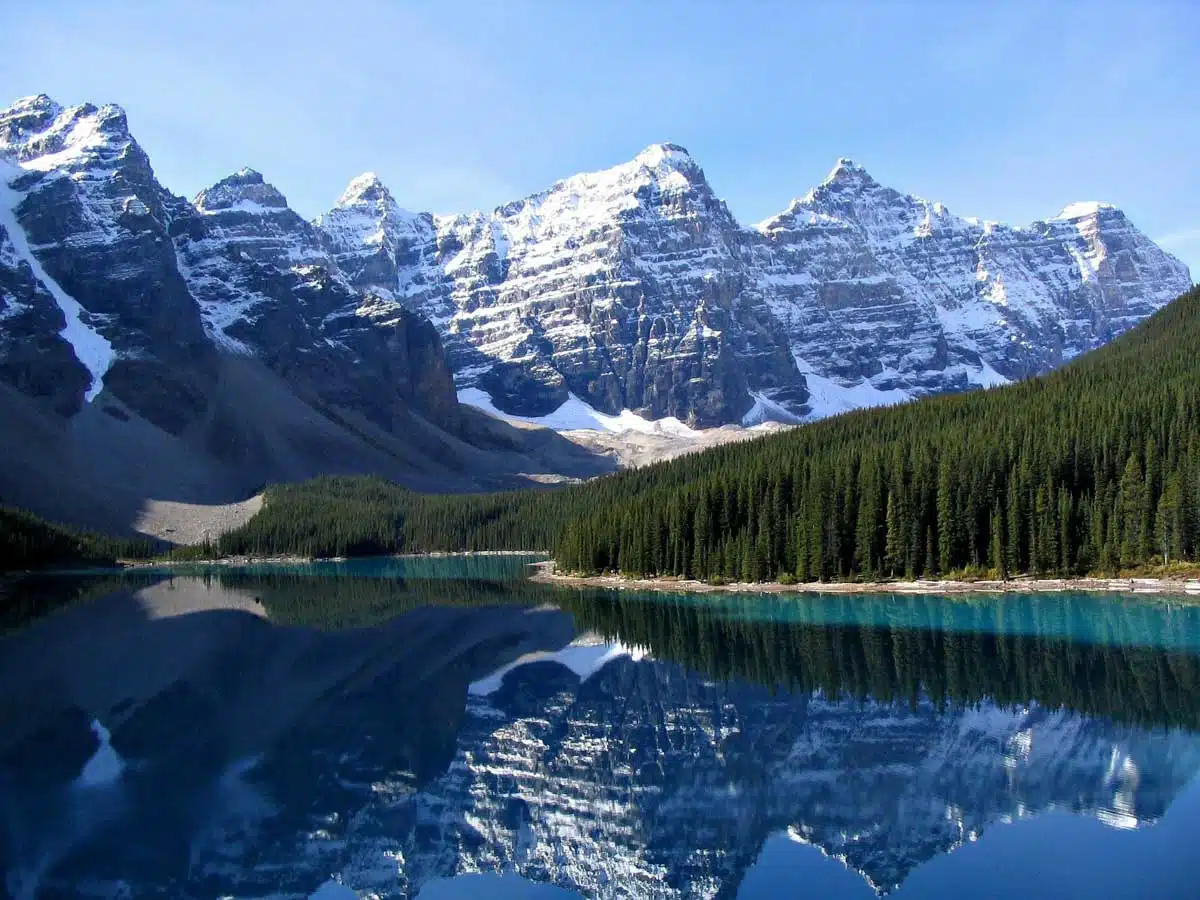
Backcountry Camping in Banff National Park
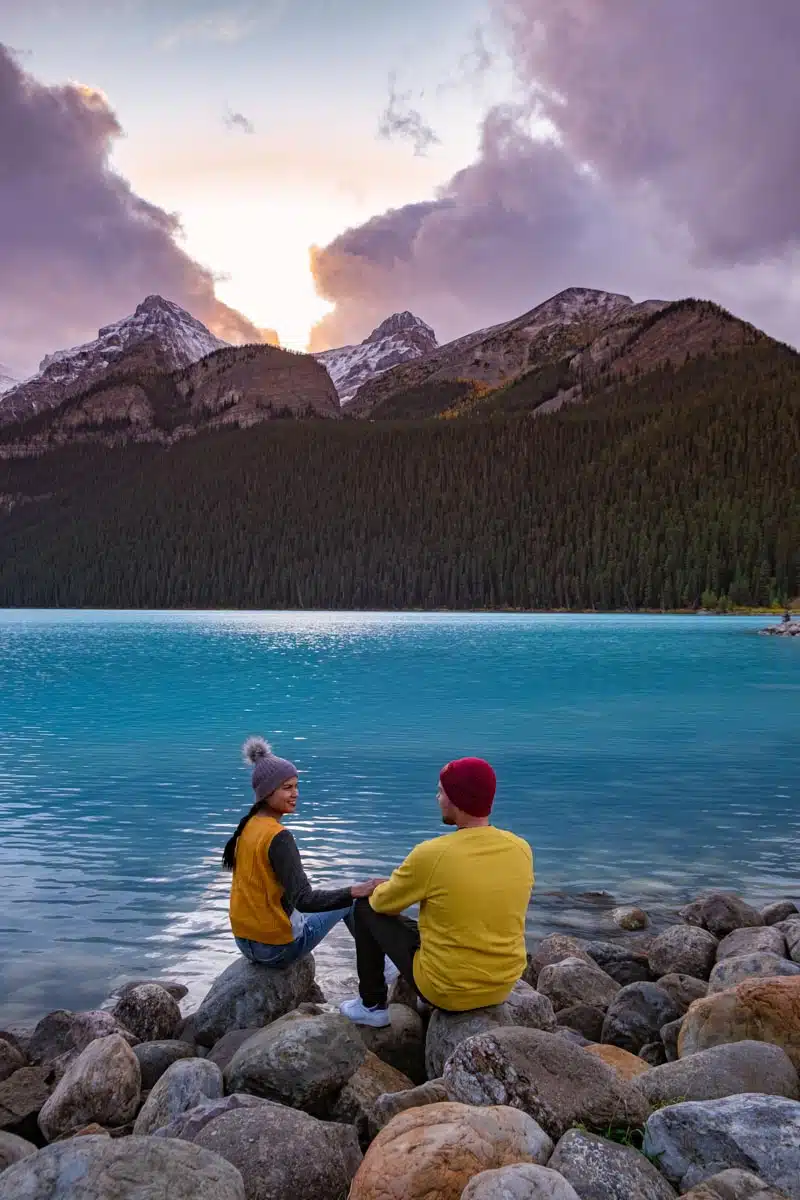
For more serious outdoor lovers, you can opt to go backcountry camping in Banff National Park.
What is backcountry camping, you may ask? This basically means that you’ll be hiking with all your gear and camping in a designated area that’s located off of the hiking trail, not the road.
It’s basically a backpacker’s heaven and a big reason why people choose to go to Banff in the first place.
Backcountry campsites in Banff boast some of the best views and campsites, but you need to know what you’re doing before you head out in an unmonitored area.
Basically, you’ll need to get a permit first and then decide where you’re going to camp. More details below…
How to Get a Backcountry Permit
Before you go camping in the backcountry areas of Banff, you will need to purchase and reserve a permit.
There are a limited number of permits issued for backcountry campsites in Banff, so be sure to book it early if you’re planning to do it.
You can learn more about permits and purchase yours here.
Tips & Rules for Backcountry Camping in Banff
You’ll also need to plan your trekking route before you go, as there are specific designated areas where you are permitted to camp.
Luckily, Parks Canada already has several suggestions for hiking routes backcountry camping areas on this page. Before you go, make sure you have all of your necessary camping gear and that you’ve mapped out your route thoroughly.
Campervan Rentals/RV Camping in Banff National Park
As Banff is open year-round, you might find that your best bet for Banff camping is to go in a campervan or RV.
The campervans will protect you from cold weather and rain, and you’ll sleep comfortably in an actual bed. And luckily, most campsites in the Banff area are welcoming towards campervans and RVs.
Just make sure you empty your sanitary waste in the proper “Sani Dump” areas, and opt for electrical campsites if you need it.
If you’re camping in a campervan, you have most of the same options for campsites in Banff available to you, as well as two more options:
- Tunnel Mountain Trailer
- Lake Louise Trailer (open year round)
Camping Near Banff
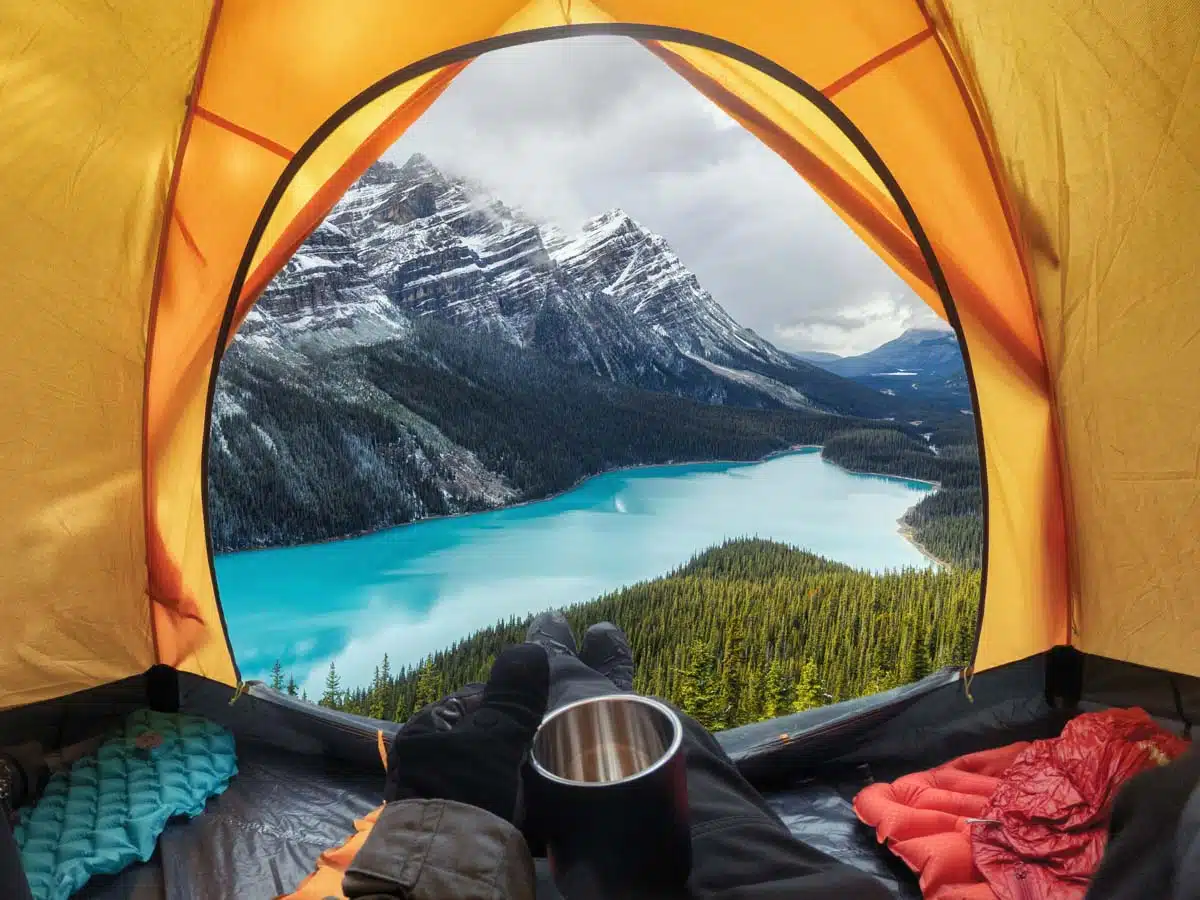
Like I mentioned before, campsites in Banff get super popular in the summer months, so much that they can fill up quickly if you don’t have a reservation. However, don’t give up!
The nice thing about having a rental car (or driving your own!) is that if you can’t find a vacancy in one of the many campgrounds in Banff, you can always drive to a nearby area and go camping near Banff.
If you’re trying to find areas to go camping near Banff, I have two recommendations: Canmore and the Icefields Parkway.
The campsites in the Icefields Parkway are listed above, and they’re all first-come first-served, so you can simply drive along the parkway and stop at each one to inquire about availability.
Camping in Canmore
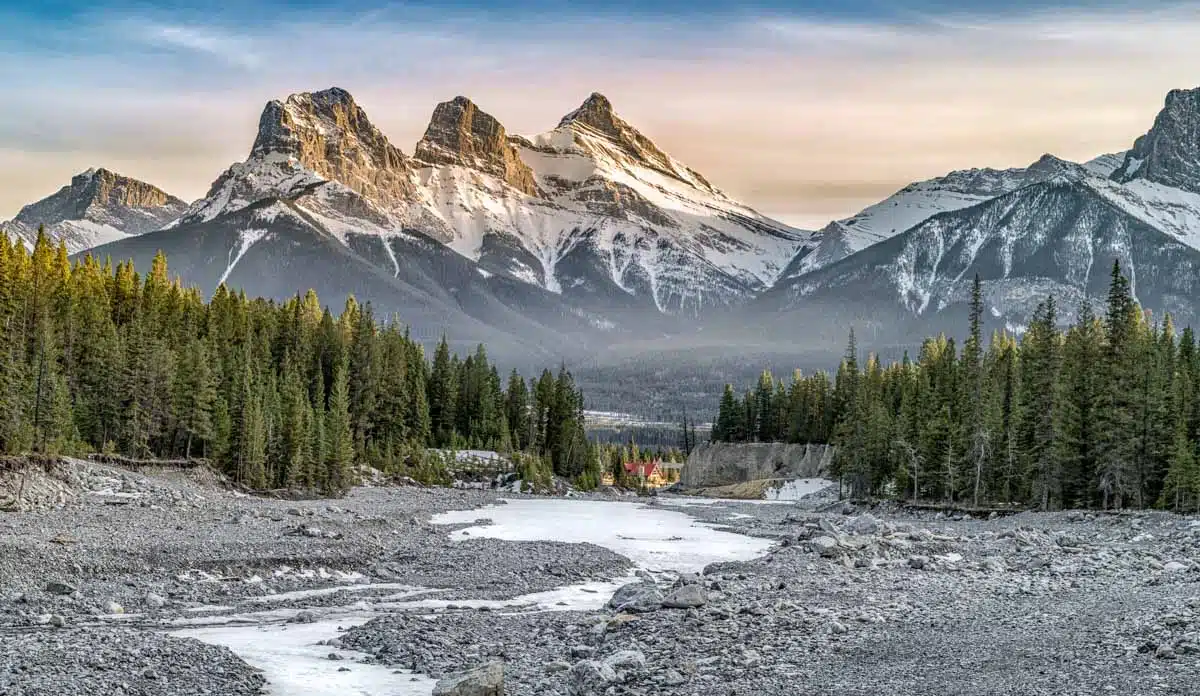
Alternatively, you can try camping near Banff in an area called Canmore. Canmore is almost exactly like Banff (full of gorgeous mountains and lakes) but it’s closer to Calgary.
You can drive to Banff from Canmore in 15-20 minutes. But Canmore is also a much less popular tourist destination (more popular with Calgary locals who won’t be camping), so there are usually more vacancies in their campsites.
Also, most of them are first-come, first-served, so it’s perfect if you’re planning to get an early start from Calgary in the morning.
Canmore campsites you may want to check out:
Boulton Creek: The most popular campsite in Canmore, located conveniently off the highway. You can actually reserve this one online.
Bow River: A campground located along the picturesque Bow River.
Lac Des Arcs: A small, scenic campground located near some stunning mountain vistas.
Mount Kidd: Large year-round campground, popular with hikers and skiers. Equipped with an indoor Campers Centre that can be used in the colder months.
Spring Creek: RV-only campsite with stunning views, located in a large field close to Canmore town.
Three Sisters: A basic, small campground that is located off the Trans Canada Highway.
Wapiti: The closest campsite to Canmore town, perfect for people who want the convenience of not having to cook meals.
Camping in Banff National Park: What You Need to Know
Banff National Park Camping Tips
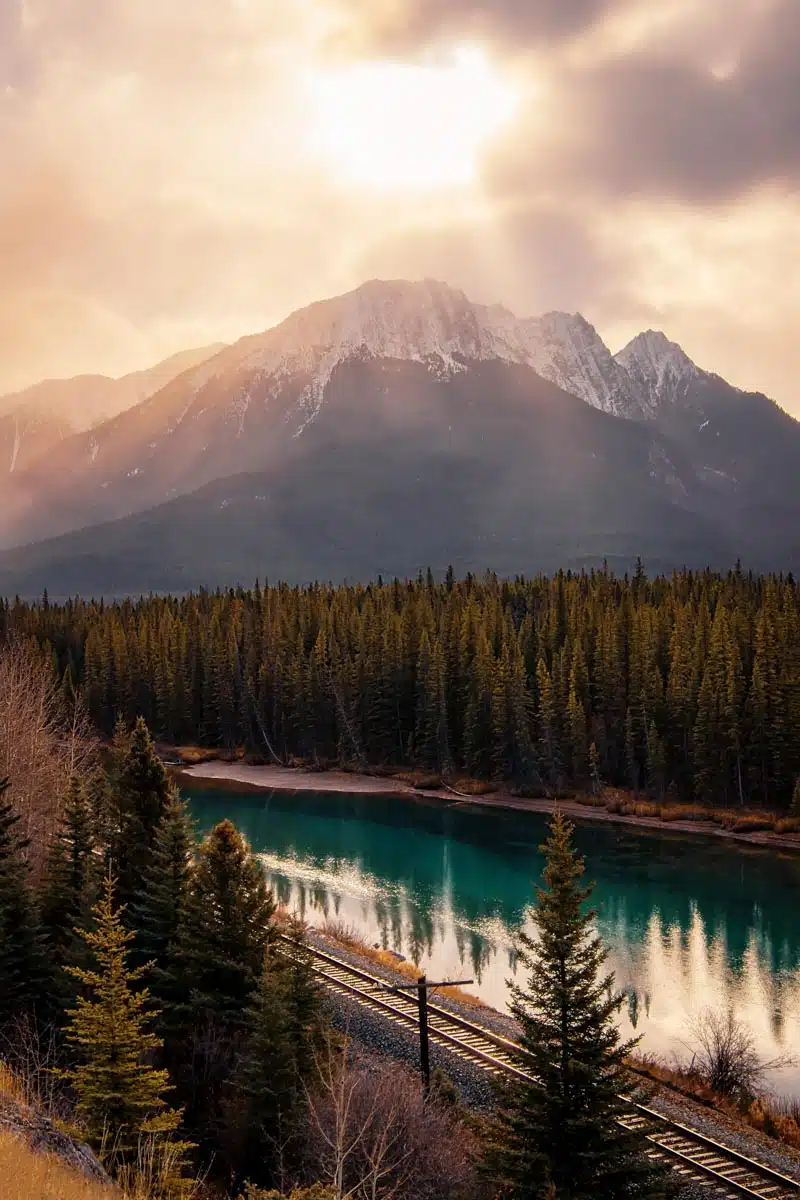
Camping in Banff is pretty straightforward, but since the park gets really crowded in the summer, it can be a little hard to navigate, especially if you’re planning a last-minute trip. Here are a few things you should know before heading to Banff:
There’s lots of wildlife all around the park. Bears, mountain goats, elk, wolves… There are these species and more all over Banff, so it’s important to know what to do in the event of a sighting.
Usually, the park rangers at each campsite will be able to tell you what kinds of animals are in the area, but it’s good to plan ahead.
Always bring bear spray, avoid hiking alone, do not keep food inside or around your tent, and heed any notices from park rangers.
Be sure to reserve your campsites in advance. Banff is one of the most popular tourist destinations in North America, so it’s really important to reserve your campsites as far in advance as possible.
Some of the more popular campsites, like Two Jack Lakeside, get completely booked months in advance! You can reserve campsites on the Parks Canada reservations page.
Frontcountry camping is well-equipped with all of the amenities you may need. The frontcountry campsites, which we’ll go over in the next section, are usually equipped with bear boxes, bathrooms, electrical hookups, and even showers. Isn’t that luxurious?
When you book any of the campgrounds in Banff, you’ll pay a small camping fee, which gives you access to your reserved campsite and the on-site amenities.
You’ll need a special permit for backcountry camping. If you want to go backcountry camping, there are special areas designated for you and rules you need to abide by.
You’ll also need to get a backcountry camping permit at one of the Parks Canada offices.
Due to regulations, fire pits usually cost extra to use. If you’re planning on building a fire, note this when you make your reservations or show up to a first-come first-served campsite.
When to Visit & Camp in Banff National Park
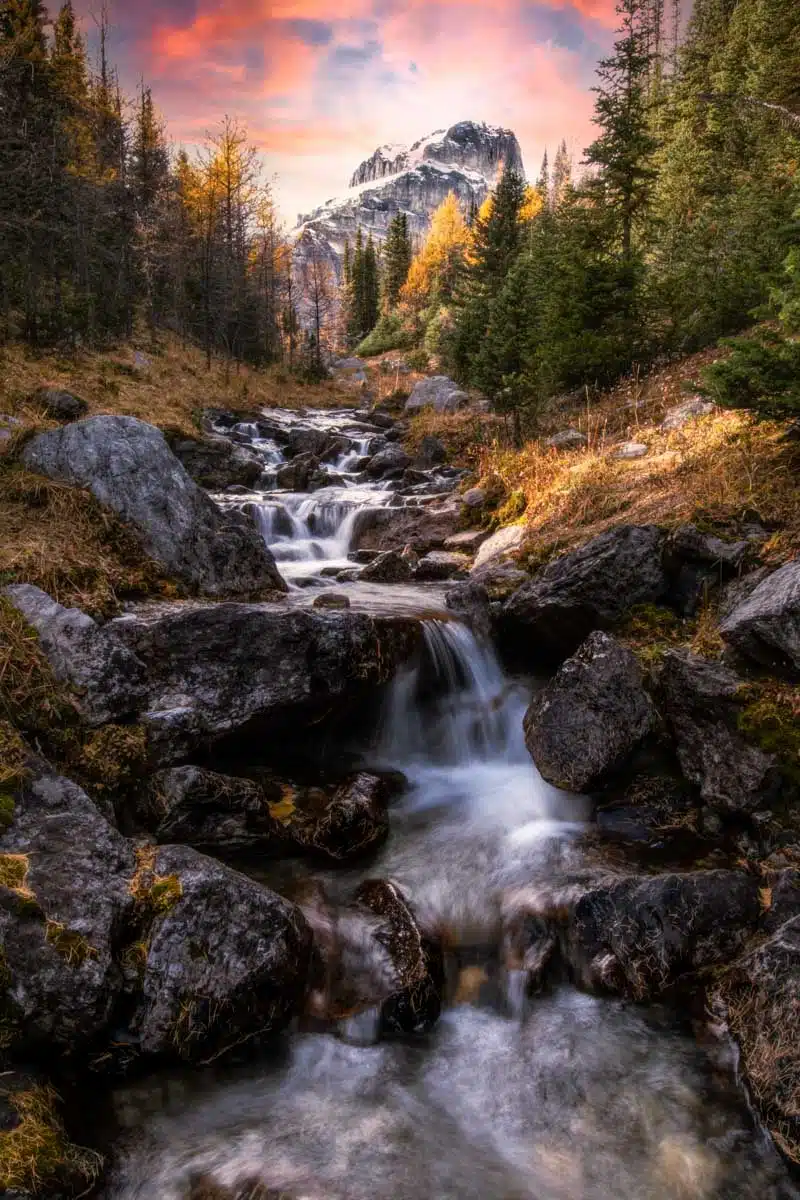
While the warmest season of the year in Banff is summer, Banff is open all year! In my opinion, the best time to visit Banff is in the spring or the fall, when the weather is warm enough to stay outside for extended periods of time but the summer crowds have subsided. It’s also a great time for hiking in Banff.
Most of the tourists flock to Banff in July and August, so if you want to avoid massive tourist crowds, avoid those months.
If you’re visiting in the winter, be sure to check the Parks Canada website so you know which parts of the park are open (and which are shut down for the season).
However, you can actually camp in Banff year-round at certain sites. I wouldn’t recommend doing this in a tent (it gets SO cold there!), but if you have a campervan or are planning on renting one, you can access some of the campsites in the area all year.
I’ll go into this a bit more in-depth later in the post.
How to Get To & Around Banff National Park
You’ll most likely begin your trip by flying into Calgary International Airport (YYC). Once you arrive, the best way to get around is by renting a car.
At Calgary’s airport, there are tons of car rental agencies you can rent from – I rented from Avis every single time I visited Banff (over 12 times!) and the process was always seamless and easy. You can also rent a car in downtown Calgary or in nearby Edmonton, at the airport or downtown.
From Calgary, you will take the Trans-Canada Highway AB-1 going West. The trip takes just over an hour to get to the front entrance of the park, where you’ll pay the park entrance fees.
Within the park, there are a few buses that go to and from the Banff town center, but for people who want to go hiking in Banff, there’s really no other way to get to the various campsites, landmarks, and hiking trails in Banff National Park.
What to Pack for Banff National Park
Of course, if you’re an avid outdoors person, you probably already know what to pack for a national park that experiences moody alpine temperatures and unpredictable conditions. But in case you don’t…
Clothing to Pack for Banff
- Waterproof hiking boots – While hiking in Banff, there’s a good chance you’ll be caught walking in mud, snow, and stream crossings. To keep my feet warm and dry during day hikes, I have a cozy pair of Columbia waterproof hiking boots that always do the trick! My boots have been with me to Patagonia, Peru, Slovenia and more, and they’re still kicking (haha, get it?!).
- Merino wool layers – It’s a really good idea to bring a merino wool baselayer, which will keep you cool in the summer and warm in colder weather. Merino is soft, sturdy, stink-free, and sweat-wicking, AKA the best fabric ever for hikers. We use Smartwool baselayers and love them.
- A waterproof rain shell – No matter what time of year it is, there’s a decent chance of sudden rain in the Canadian Rockies, even if the skies are blue. Bring a sturdy, waterproof rain jacket to stay warm and dry while hiking in Banff.
- A compressible down jacket – Temperatures in Banff can be chilly even in the summer, especially as you gain altitude in your hikes. For this reason, I always make sure to pack my thermal puffer, all rolled up into a tiny ball that I can shove into the bottom of my day pack.
- Mosquito repellent, sunscreen, and sunglasses – Duh.
Gear to Pack for Banff Camping
- Tent – A lightweight, packable tent is a must for Banff camping. When I go camping in alpine areas, I use a Marmot 2 person tent that I adore.
- Sleeping bag – Banff can get seriously cold at night, even in the summer. Be sure to come prepared with a warm sleeping bag for the chilly evenings. I’d recommend also bringing a thermal sleeping bag liner just in case!
- Thermal sleeping mat – Don’t be an idiot like me and bring a thermal sleeping mat! I have an inflatable sleeping mat from REI that I love.
- Fire starting materials – Newsflash for beginner campers: it’s hard to start a fire. It’s a lot easier when you have matches, lighter fluid, etc., so don’t forget those things if you plan to use the fire pits.
- Cooking & cleaning items – If you’re planning to cook, you’ll want a mess kit and some pots and pans. You’ll also need some eco-friendly soap and a scrubber to clean it with.
- Head lamp – Sometimes the best views are at sunset or sunrise, and you’ll end up needing to hike when it’s a bit dark outside. I love my trusty head lamp for hiking in the early morning or late evening.
- Hammock – Totally optional, but trees are abundant in Banff and you may just want to take a little nap with a view… a packable 2-person hammock can help with that.
- Reusable water bottle and filter – Reminder: you’re in a national park and it’s super important to minimize your plastic consumption. However, clean water is a must, so we always bring water purifiers and a reusable water bottle. I love pairing my rock-solid Hydro Flask with my SteriPen Aqua and Sawyer Products Mini Water Filter for clean, cold water on the go.
- Bear spray – Do not go camping in Banff without a can of bear spray. You probably won’t have to use it, but this will help you out in the event of a bear sighting. You can get bear spray at any outdoor retailer in Canada, just make sure to leave them behind before you fly home.
The Secret to Planning a Last-Minute Banff Camping Trip
So, you’ve packed your bags, you’re ready to hit the road and pitch your tent….and you realize that there are NO campsite reservations available. Now, you have two options: cancel the trip or try and find some kind of other accommodations. Here’s what you should do:
- Try one of the first-come, first-served campsites I mentioned above in Banff
- Then, try to find a place to go camping near Banff
- If that doesn’t work, drive back to Calgary, where there are plenty of places to stay
I hope this guide helped you figure out exactly how to plan your Banff camping trip! There are a lot of great campgrounds in Banff to choose from, and I hope you’re able to snag a space in a few of them to enjoy the park to the fullest.
Did you enjoy this post? Pin it for later
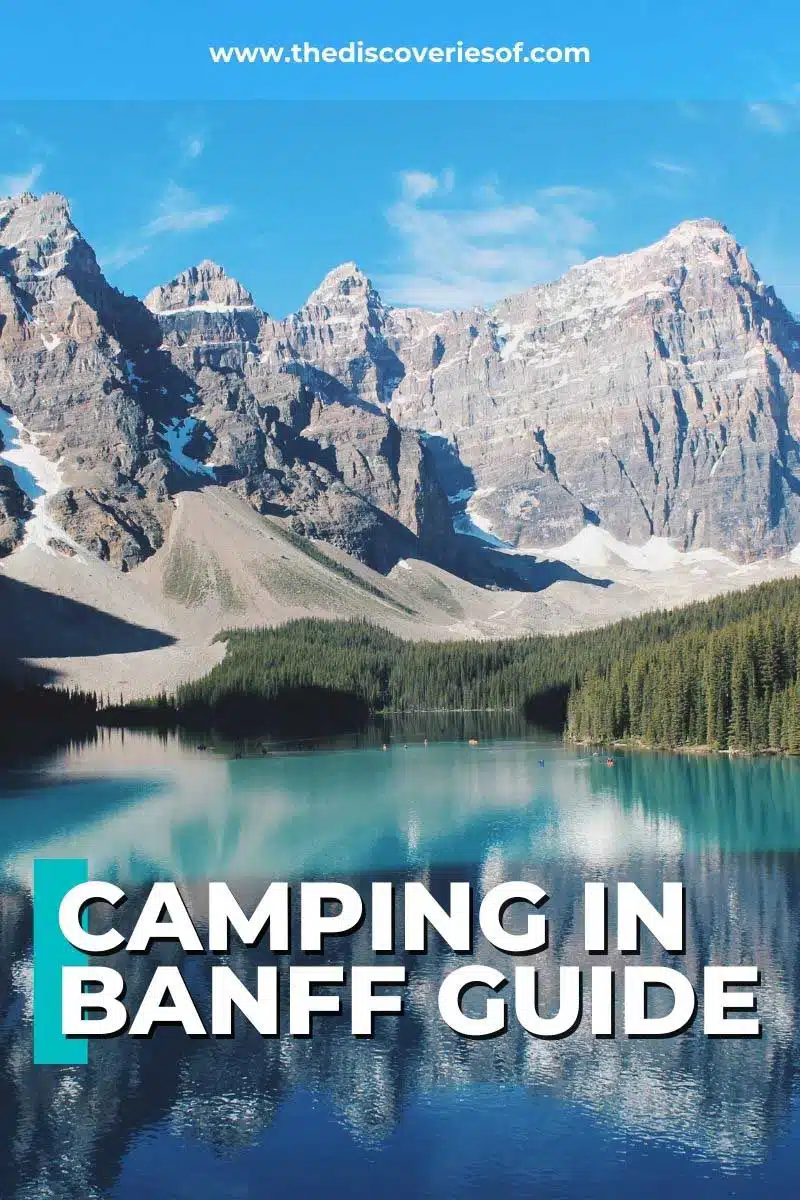
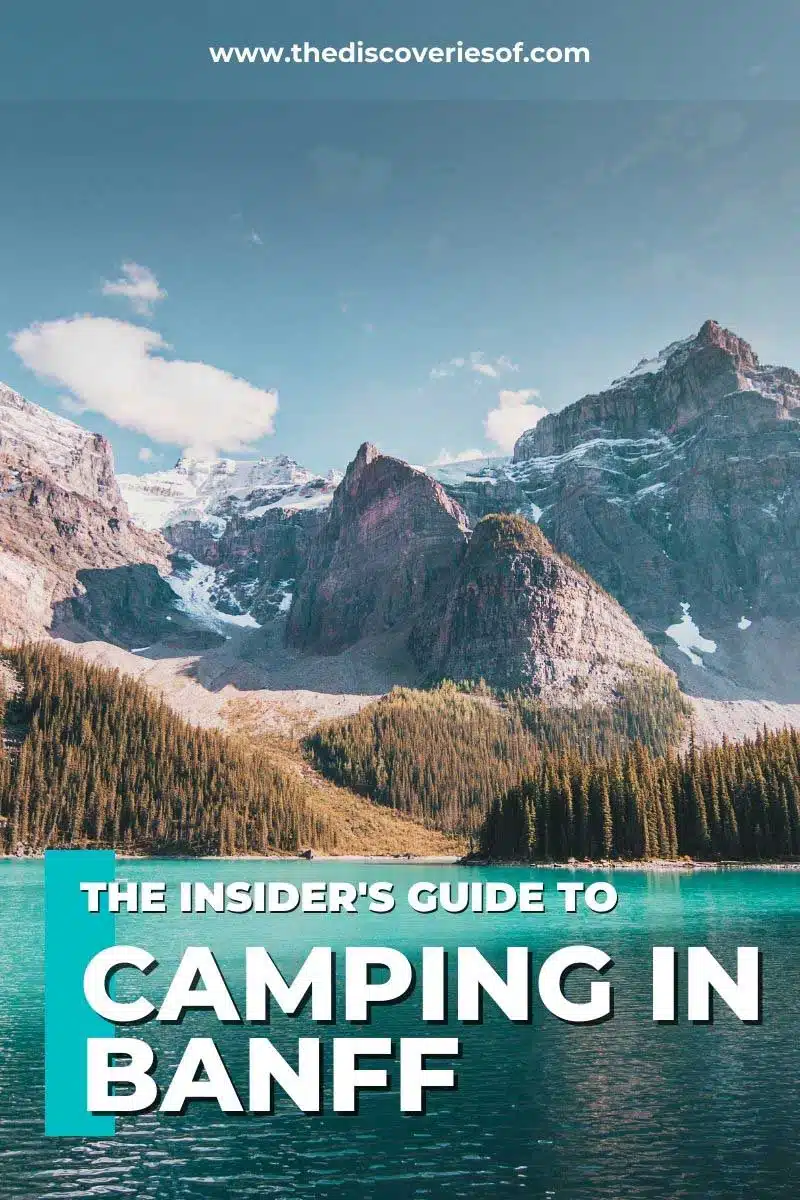

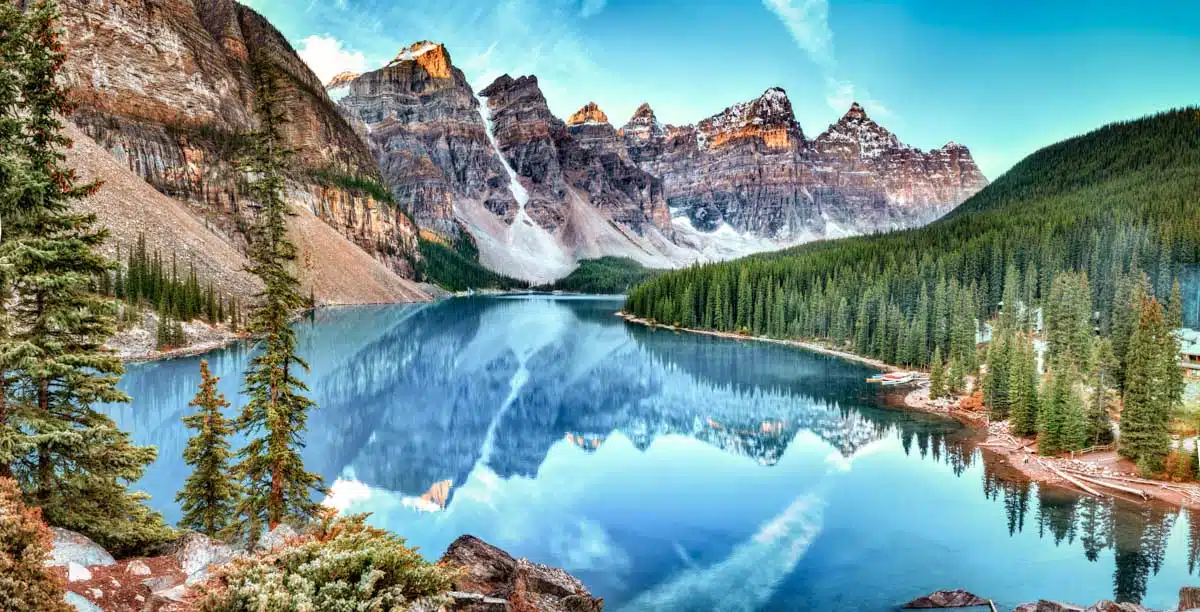
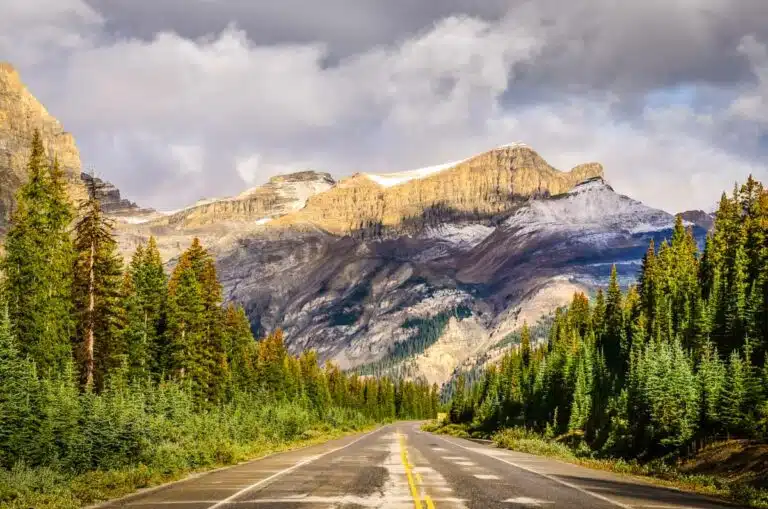
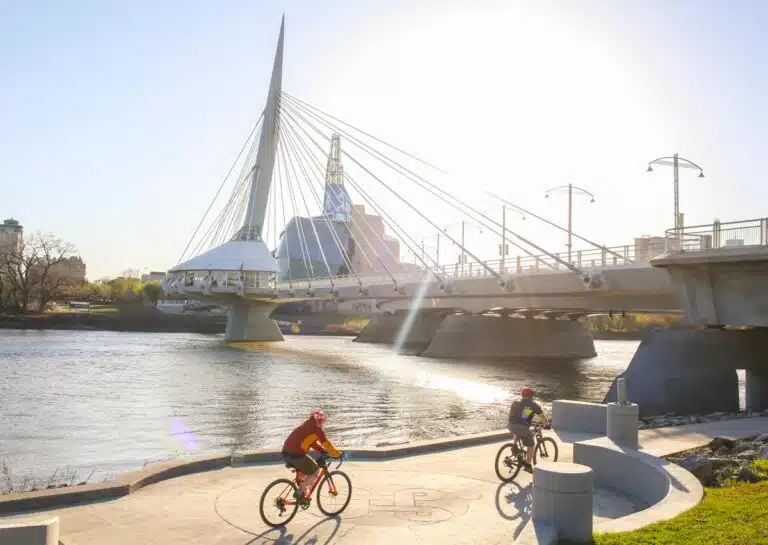
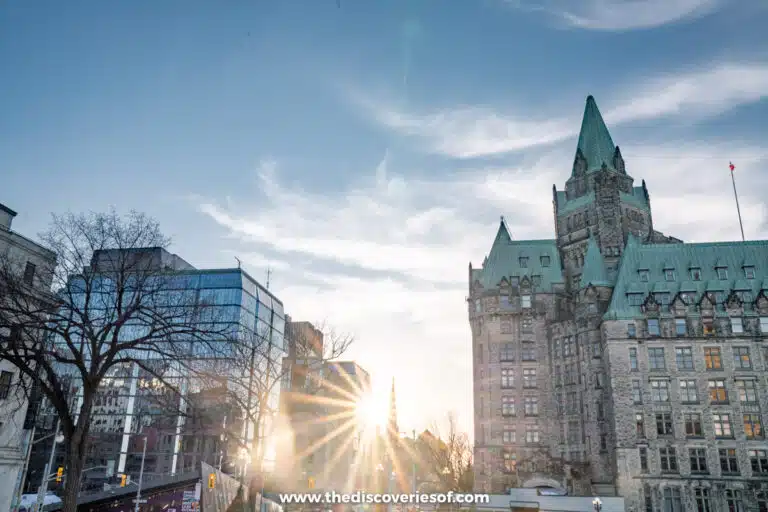
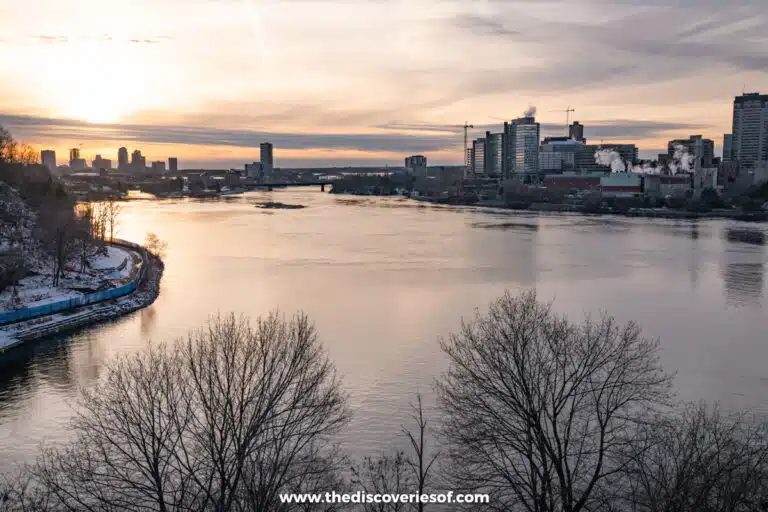

I would love to take an RV to Banff one year…I’ve been too afraid of the cold to go, but there are some great tips here so I’m definitely tempted!
I’m going to camp there in June hopefully!! Love all these tips girl! I’m going to use your guide for sure to help plan my trip